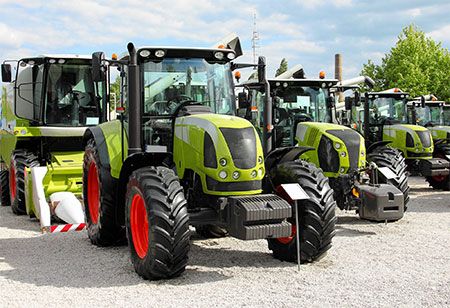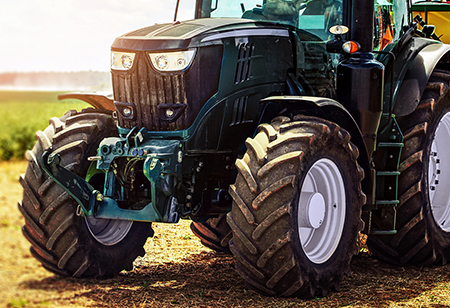
The changing seasons bring new challenges and opportunities to your farm. As winter fades and spring’s warmth embraces the land, it’s time to prepare your machinery for the busy planting and growing months ahead. Or maybe you’re looking ahead to winter when the harsh cold can take a toll on your hard-working equipment.
No matter the season, taking good care of your farm machinery is essential. It’s not just about keeping things running smoothly today-it’s about protecting your investments for years to come. With some seasonal maintenance and preparation, you can ensure your equipment operates at its best, maximizing efficiency and minimizing costly breakdowns.
Here’s a comprehensive guide to maintaining your farm machinery year-round:
Spring: Preparing for Planting
Before sourcing replacement parts for your equipment from suppliers and service providers such as Maupin’s, remember that spring is a time of renewal. Just like your crops emerge from dormancy, your farm equipment needs some TLC to be ready for the planting season. This includes performing routine maintenance tasks that were likely neglected during the colder months.
During spring, here are some maintenance tips to keep in mind:
1. Change the Oil and Filters: Introducing fresh engine oil and installing new filters eliminate contaminants that have built up during the equipment’s idle time. This step is crucial for maintaining optimal engine health and minimizing wear and tear, safeguarding your machinery’s longevity and efficiency.
2. Inspect and Follow Manufacturer’s Lubrication Guidelines: Conduct a thorough examination of belts, hoses, and linkages for any signs of wear, such as cracks, fraying, or leaks. It’s also essential to adhere to the manufacturer’s specific recommendations for lubrication. This includes using the correct type of lubricant for each part of your machinery and adhering to the suggested lubrication intervals. Following these guidelines reduces friction and helps in averting premature failures, extending the lifespan and efficiency of these critical components.
3. Sharpen Blades and Tillers: Efficient operation requires sharp equipment. Dull blades and tillers can cause inefficient soil penetration, increased fuel consumption, and poor planting conditions. Before sharpening, make sure the equipment is powered off and that the keys are removed to prevent unintended operation. Wear protective gloves and use appropriate tools to sharpen blades and tillers, facilitating clean cuts and precise seeding.
4. Test and Calibrate: To avoid the frustration of unexpected equipment failures, make sure to test and adjust your machinery beforehand. You may also need to calibrate seeders and planters under actual field conditions whenever possible. This extra step is vital for verifying the operational integrity of your equipment in the environment it will be used. Calibration under field conditions can sometimes reveal issues that aren’t apparent during static tests, allowing you to fine-tune seeders and planters more accurately to achieve precise seeding rates.
After addressing these preparatory steps, your farm equipment will be in peak condition and ready to tackle the demands of the upcoming planting season.
Summer: Maintaining Peak Performance
Summer is the heart of the growing season, a time when your machinery will be pushed to its limits. Ensuring that your equipment maintains peak performance during these critical months is essential to avoid unexpected breakdowns and keep operations running smoothly. Here are some key maintenance tips to consider:
1. Monitor Fluid Levels: Regularly checking and topping off engine oil, coolant, and hydraulic fluid levels is essential. Immediate attention to any leaks can prevent overheating and hydraulic problems, which can cause severe damage to your machinery.
2. Clean Air Filters: The summer air is often filled with dust and debris that can clog air filters, restricting airflow and reducing engine power. Following the manufacturer’s schedule for cleaning or replacing air filters ensures that your engine operates at optimal efficiency.
3. Check Tires and Tracks: To maintain traction and fuel efficiency, inspect tires and tracks regularly for uneven wear or damage. Addressing wear and tear promptly by making necessary repairs or replacements can save time and resources in the long run.
4. Stay Hydrated: This applies not only to your crops but to your machinery as well. High temperatures can overtake your equipment’s cooling system. Keeping the radiator clean and ensuring coolant levels are topped off with the correct coolant/water mixture will help prevent overheating.
Following these maintenance tips can significantly contribute to the longevity and performance of your agricultural machinery during the summer months. Regular upkeep prevents costly breakdowns and ensures that your equipment is ready to meet the demands of the growing season, helping you achieve successful operations.
Fall: Harvesting and Storage
Fall isn’t just about the colorful leaves and cooler temperatures—it’s a crucial time for those who work the land. As the season of harvest, it brings the fruits of a year’s hard work to the forefront. However, once the harvesting is done, attention turns to the equally important task of preparing agricultural machinery for the off-season.
Here’s how to ensure your equipment remains in top condition and is ready to hit the ground running next spring:
1. Clean Thoroughly: Post-harvest, it’s essential to clear your machinery of all dirt, crop residues, or any other debris. This cleaning step is vital not only for maintaining the appearance and functionality of your equipment but also for preventing the onset of rust and corrosion during the storage period. Moreover, a clean start in the next season makes pre-season maintenance smoother and less time-consuming.
2. Change Engine Oil and Filters: Another critical step before putting your machinery away for the off-season is changing the engine oil and filters. After a season’s work, oil can accumulate contaminants that may harm your engine. Changing the oil and filters will remove these contaminants, ensuring your engine is protected and ready for storage, ultimately prolonging its life and maintaining its efficiency.
3. Battery Care: Equipment that remains idle for extended periods is prone to battery discharge. To mitigate this, there are two effective strategies: either remove the battery and store it in a cool, dry place or keep it connected to a battery maintainer. If opting for a battery maintainer, it’s essential to use a smart maintainer that automatically adjusts the charging rate as necessary. This smart technology prevents overcharging, which can significantly extend the battery’s life. Both approaches help ensure your equipment starts effortlessly when you’re ready to resume work.
4. Winterization: For those in regions experiencing harsh winters, it’s vital to ensure your machinery is adequately protected against freezing temperatures. Modern coolants typically offer both cooling and freezing protection. Instead of draining and replacing the coolant annually, check the antifreeze level and concentration before winter. Use a coolant tester to ensure it meets the manufacturer’s specifications for freeze protection. This approach prevents coolant from freezing and causing engine damage, thereby avoiding costly repairs. Always refer to your equipment’s manual to understand the specific coolant requirements and maintenance practices recommended for your machinery. Taking these steps is crucial for keeping your equipment safe through the winter months.
After completing these steps, you can rest assured that your machinery is well-prepared for the off-season. Not only does this preparation help in maintaining the operational integrity and longevity of your equipment, but it also sets you up for a smooth and efficient start to the next farming season. Properly winterized and stored equipment is less likely to encounter issues, meaning you can focus on what you do best without worrying about preventable maintenance problems.
 Winter: Off-Season Maintenance
Winter: Off-Season Maintenance
Winter’s chill offers a unique opportunity for off-season maintenance, turning the cold months into a productive period for equipment and field care. As the landscape rests beneath a serene snow blanket, consider this time an invaluable chance to prepare for the busier seasons ahead. Here are vital steps to ensure your operations run smoothly once the snow melts:
1. Schedule Major Repairs: Utilize the winter months to undertake significant repair work or overhauls that would be disruptive during the active growing and harvesting seasons. Addressing these repairs now minimizes downtime and ensures readiness for peak operational periods.
2. Review Manuals: The off-season is ideal for refreshing your knowledge of the maintenance requirements of your equipment. Delve into owner’s manuals and service schedules to pinpoint necessary upkeep tasks, preparing you to tackle them ahead of time.
3. Organize Spare Parts: Ensure you have all essential spare parts on hand to avoid operational delays in the spring. Inventory your current stock and order additional parts as needed, organizing them for easy access.
4. Lubricate and Protect: Apply anti-rust lubricants to exposed metal components of your equipment. This preventive measure guards against corrosion, keeping your machinery in prime condition for spring activities.
Incorporating these maintenance practices during winter not only preserves the condition and functionality of your farm equipment but also positions you for a seamless transition into the bustling spring season. This proactive approach to off-season maintenance ensures that when your fields awaken from their winter slumber, you and your equipment will be ready to spring into action.
Conclusion
Maintaining your farm machinery for each season might seem daunting, but with a structured approach, it’s entirely manageable. By focusing on preventive measures and staying vigilant about the unique needs of each season, you can keep your machinery running efficiently and extend its lifespan. Remember, the goal is not just to react to problems as they arise but to anticipate and prevent them, ensuring your farm’s productivity and profitability.
We use cookies to ensure you get the best experience on our website. Read more...